
What if one day you open your kitchen cabinet and see a silver spoon instead of a regular steel one? A bit confused at first, but you will jump in joy! This is the same reason why the 1943 Steel penny is unique. The citizens of the US saw only the copper pennies, but the 1943 issue of the penny was composed of steel which was highly astonishing and new for everyone.
Here’s everything that influenced the 1943 steel Penny value!
In short, there are three main factors: condition, mintmark, and errors. These three factors can impact collectively or sometimes individually. Let’s break down the 1943 penny value puzzle, piece by piece!
While you might think the change in metal composition could be an innovative step. However, that’s not the case; World War II was the reason. The demand for metals like copper and tin grew drastically to aid the war effort with munitions and other military supplies.
In this situation, the U.S. government decided to opt for steel to make currency coins since it was cheaper and more accessible. With the use of steel for the 1943 penny, the U.S. Mint produced a lustrous gray penny coated in zinc for the first time in American coinage history. This steel penny was struck in three facilities of the US Mint: Philadelphia, Denver, and San Francisco.
With all these unique and jaw-dropping points, you might wonder if the 1943 penny value is as high as Burj Khalifa. Unfortunately, with over a billion coins produced, these pennies are not particularly rare.
TL;DR The value of the 1943 steel penny ranges from a few cents (10-13) to a few thousand dollars ($200- $4,000). The condition, the mintmark, and the errors influence this value range. The value for circulated coins that survived is comparatively lesser than uncirculated coins. The uncirculated condition coins mean the coins are in a mint state that never left the mint.
The mint marks are the initials of the mint that the coins were struck in. The US Mint rare coins generally were produced in Philadelphia (no mintmark), Denver (D), and San Francisco (S). Furthermore, if your coin has a low mintage mintmark while in pristine condition, the value is far higher.
Lastly, the errors! The coin errors are the manufacturing defects from the mint that make the coin more valuable rather than decreasing it.
Here’s a comprehensive table that displays the different values of 1the 943 penny:
| Condition | 1943 No mint mark steel penny | 1943 D steel penny | 1943 D RPM steel penny | 1943 S steel penny |
|---|---|---|---|---|
| Good | $0.17 | $0.23 | $17 | $0.28 |
| Very good | $0.23 | $0.34 | $28 | $0.34 |
| Fine | $0.34 | $0.40 | $46 | $0.46 |
| Very fine | $0.40 | $0.46 | $57 | $0.75 |
| Extra fine | $0,46 | $0.57 | $68 | $0.87 |
| AU | $0.57 | $0.87 | $81 | $1.16 |
| MS 60 | $2.88 | $3.38 | $115 | $6.81 |
| MS 65 | $9.35 | $11 | $1,161 | $23 |
| Date & Mint | Circulated | Uncirculated | ||
|---|---|---|---|---|
| Buy | Sell | Buy | Sell | |
| 1943 Bronze * | $29,000.00 | $18,000.00 | $190,000.00 | $140,000.00 |
| 1943-D Bronze * | $57,000.00 | $38,000.00 | $360,000.00 | $260,000.00 |
| 1943-S Bronze * | $92,000.00 | $62,000.00 | $590,000.00 | $400,000.00 |
The 1943 penny can be among the most valuable coins, but surprisingly, it was unliked by the masses. To aid the war effort, the US Mint replaced the copper pennies with steel pennies. Steel was used as the base metal and coated with pure zinc. However, zinc oxidizes over time since the circulation will expose it to moisture. After the timely oxidization, the coins turn dull, dark gray.
The masses didn’t like this color change, and to add salt to it, the manufacturing process contributed. Even the planchets used were flawed and rolled into steel sheets to the proper thickness. The sheets were passed from the blanking press that punched coin blanks out of it.
Now, this manufacturing process resulted in exposed bare steel at the edge of the coin. The moisture and wear reacted with the bare steel, making the coin rust, regardless of how its surface was. This rejected coin was also confused with the same size dime by the people! In any way, this might be a major flaw, but the 1943 penny value for higher grades is high.
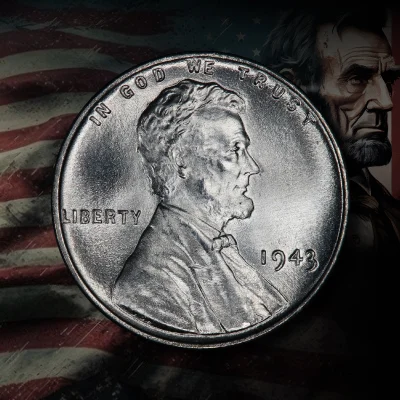
The obverse of the Lincoln Penny includes the effigy of Former President Abraham Lincoln designed by Victor David Brenner. This effigy has been adorning the coin since its introduction in 1909. The designer's initials are engraved on Abraham Lincoln's shoulder.
Did You Know?
Brenner’s initials appeared on the reverse but were removed due to criticism. These initials were restored in 1918 on the obverse.
Inscriptions:
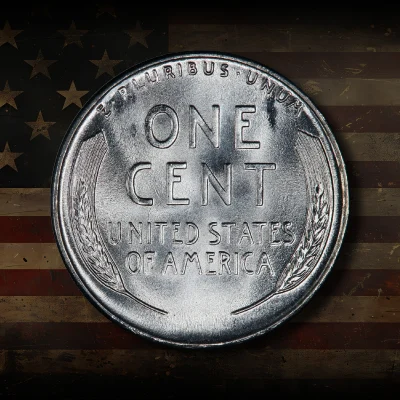
The reverse of the 1943 steel penny is yet another iconic and historic design. This design includes two wheat ears on each side. These wheat ears have a plethora of meanings, from being the staff of life to prosperity. Following this are the inscriptions for the denomination, the US motto, and the engraving of the country of issue.
Inscriptions:
| Composition | steel core clad in zinc. |
| Weight | 2.7 grams |
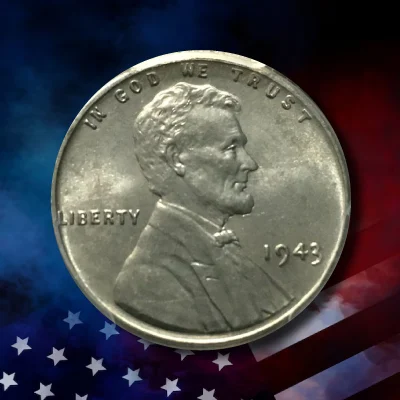
The 1943 pennies struck at the Philadelphia facility of the US Mint lack a mintmark. Thus, if you hold a penny without a mintmark, it is probably struck at the Philadelphia Mint. The mintage here was the highest, with more than 684 million coins produced.
Based on the grade (1 to 70) and condition of the 1943 (P) no mint mark Steel Penny value ranged from $11 to $35,000.
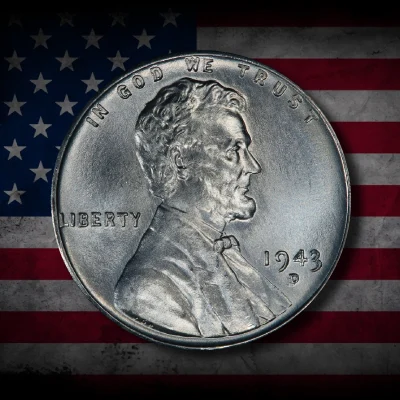
The 1943 Pennies bearing the D mintmark were struck at the Denver facility. The mintmark is depicted below the date on the obverse. Compared to the Philadelphia mint, the Denver mint only produced 217 million coins. Regardless of the vast mintage number gap, these pennies are around the same value as the Philadelphia ones.
The values from decent to a good condition penny (even around AU- Almost Uncirculated) remain around $1 to $7. The worth starts to take off from MS60, which is $11.

If you see an “S” below the date on the obverse of the 1943 Steel Penny, then a coin is struck at the San Francisco facility. Among the three, the San Francisco Mint had the lowest mintage of 191 million pennies.
The possibility of getting a valuable 1943 S Steel Penny is higher since collectors seem to hoard excellent condition pennies making them sought after even today. The good condition pennies are not in the question when it comes to value.
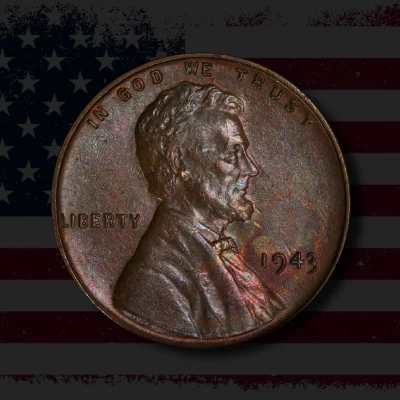
In the world of coins and errors, people were introduced to one of the rarest coinage errors, the transition error. As the moniker suggests, the 1943 bronze cent was when pennies were struck on the old type planchet.
These pennies were struck on the traditional bronze planchet instead of the new steel and zinc planchet. Regardless of any condition, these pennies are highly valuable.
Brace yourself for these values!

Yet another rare error, this time with the Denver mint struck 1943 Steel Pennies. The Repunched Mintmark (RPM) error occurs when a second mintmark is punched over the first, resulting in an overlapping “D” inscription.
A rare error on an already unique coin makes it valuable regardless of condition. The pennies in good condition can be valued at $55, which rises up to $175 for grade XF45.
After knowing the jaw-dropping values of these pennies, you would look at the penny and wonder, Is this for real? What if it’s fake? A completely valid question!
Here’s how you can spot fake 1943 Steel Pennies:
The 1943 steel pennies were made from a steel base and a zinc finish, giving them a light gray color. However, if your coin has a bronze composition of copper and zinc, they will be very rare. Furthermore, if you have a copper and zinc composition coin with a red finish, you are waiting for life-changing cash!
Despite being made with steel for the first time and visibly rejected by the masses, the condition, errors, and mintmarks are three factors that will make your 1943 penny valuable.
Counterfeit and phony coins are common at this point. The 1943 brown penny that has jaw-dropping worth is prone to such acts. To identify whether your coin is real or fake, use a magnet. Since counterfeit coins usually are copper-coated steel pennies, the magnet will reveal the fake one.
The most expensive 1943 pennies are made from copper planchets instead of steel. These coins with a bronze shade are highly valuable, from a few hundred dollars to thousands of dollars for red variants.